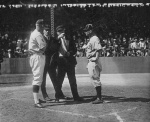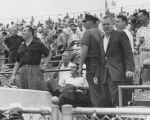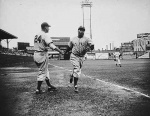The Saints-Millers Holiday Series
This article was written by Joe O’Connell
This article was published in The National Pastime: Baseball in the North Star State (Minnesota, 2012)
On October 26, 1960, Calvin Griffith received permission to move his Washington Senators ballclub and bring major league baseball to Minnesota. As a result, in 1961 the cities of Minneapolis and St. Paul were joined in support of one team. Until the coming of the Twins, however, the two cities had been supporters of their own individual teams. The earliest recorded competition between a St. Paul and a Minneapolis team occurred on May 24, 1867, when the North Star Club of St. Paul played the Minneapolis Club. The St. Paul Pioneer Press reported that the game was played “on the prairie near the Fairgrounds.” Before the contest the North Star Club was treated to a sumptuous dinner by their Minneapolis hosts. The North Stars unceremoniously repaid this hospitality by crushing Minneapolis, 56–26. The game was completed in a mere two hours and 20 minutes, despite the scoring of 82 runs. Afterward, the St. Paulites were again the guests of the Minneapolitans for a “fine supper.” Both meals were served at the Nicollet House in Minneapolis.1
 By the mid-1870s both cities were hosting professional teams, and for the rest of the nineteenth century Minneapolis and St. Paul fielded minor league teams on an on-again, off-again basis. In 1902 the rivalry took on a revitalized significance when the Apostles (as the St. Paul club was originally known) and the Millers began play in the new American Association.
By the mid-1870s both cities were hosting professional teams, and for the rest of the nineteenth century Minneapolis and St. Paul fielded minor league teams on an on-again, off-again basis. In 1902 the rivalry took on a revitalized significance when the Apostles (as the St. Paul club was originally known) and the Millers began play in the new American Association.
One of the more interesting elements of this rivalry was the holiday twinbills scheduled between the clubs. On Decoration Day (later Memorial Day), the Fourth of July, and Labor Day, two games would be played: one in St. Paul and the other in Minneapolis. The cities would alternate which city hosted the morning and which the afternoon game. Don Zimmer, who spent over 50 years in the major leagues as a player, coach, and manager, and played for the Saints during parts of the 1952 and 1954 seasons, recalled, “the Saints-Millers strong rivalry was unusual for minor league baseball, probably due to the Dodgers-Giants rivalry at the major league level.”2 By the mid-1940s, Minneapolis was a Giants triple-A affiliate, and the Saints were a triple-A farm of the Dodgers.
The competition was also reflected in newspaper coverage of the teams. On May 31, 1920, at Lexington Park, the Saints home field, Huck Sawyer hit two home runs for the Millers in a Minneapolis victory. This prompted a St. Paul Pioneer Press sportswriter to accuse Sawyer of having “Babe Ruth delusions.”3
Joe Hauser of the Millers went into the 1933 Labor Day twinbill against St. Paul with 62 home runs on the season, hoping to break his previous record of 63, attained three seasons earlier with Baltimore in the International League. During the morning game in St. Paul Hauser arrived at the plate in the seventh inning without a hit in three at bats. At the time the right-field fence stood atop an embankment 365 feet down the line, a long target for a left-handed batter such as Hauser. Nevertheless, he clobbered the ball over the right field fence and added one more in the ninth for number 64. He went on to finish the season with 69, which at the time established a new professional record.
 Ted Williams joined the Millers in 1938. He was only 19 but went on to win the American Association Triple Crown. He also led the Association in runs scored, total bases, and walks. Williams enjoyed only modest success, however, versus the Saints in the holiday twinbills. In the afternoon game on Memorial Day at Lexington Park, Williams had one of his best holiday games, going 2-for-3 with a home run and leading the Millers to a 2–1 victory. On July 4 Williams went 0-for-4 in the morning game as St. Paul defeated the Millers 8–1 before 8,056 fans, the record to that point. The afternoon game was postponed due to rain. In the Labor Day twinbill, Williams was 3-for-8, but St. Paul won both, 9–4 and 6–1.
Ted Williams joined the Millers in 1938. He was only 19 but went on to win the American Association Triple Crown. He also led the Association in runs scored, total bases, and walks. Williams enjoyed only modest success, however, versus the Saints in the holiday twinbills. In the afternoon game on Memorial Day at Lexington Park, Williams had one of his best holiday games, going 2-for-3 with a home run and leading the Millers to a 2–1 victory. On July 4 Williams went 0-for-4 in the morning game as St. Paul defeated the Millers 8–1 before 8,056 fans, the record to that point. The afternoon game was postponed due to rain. In the Labor Day twinbill, Williams was 3-for-8, but St. Paul won both, 9–4 and 6–1.
Ab Wright’s remarkable performance for the Millers marked the holiday twinbill of 1940. In the morning game on July 4 at Nicollet Park in Minneapolis, Wright hit for 19 total bases: four home runs and a triple, with seven runs batted in. The Millers won the game 17–5 in front of a crowd estimated at 7,000.
Late in the 1945 season, St. Paul got a new shortstop, Bill Hart. He put up some exceptional numbers in just 38 games, batting .368 with 46 RBIs and 17 home runs. On Labor Day Hart hit four home runs at Lexington Park in a 6–1 victory over the Millers.
In 1948 Roy Campanella became the first black player in the American Association. On Memorial Day at Nicollet Park, Campanella, in his first Twin Cities appearance as a Saint, hit two home runs to lead St. Paul to an 11–6 victory over the Millers.
On Memorial Day, 1950, the Millers dominated their cross-town rivals. In the morning game at Lexington Park Minneapolis beat the Saints 10–4. During that game two Millers, second baseman Dave Williams and outfielder Joe Lafata, collided while chasing down a fly ball. No stretcher could be found, and consequently a door was used as a substitute. Fortunately, their injuries were not serious, and both played in the afternoon game at Nicollet Park. Williams showed no sign of injury as he hit two home runs and drove in eight to lead the Millers to a 28–9 victory, tying an American Association record for most runs scored by one team.
Twin Cities baseball fans were treated to a double slugfest on Memorial Day in 1955. In the morning contest Minneapolis defeated St. Paul, 14–12, at Nicollet Park, with the teams combining for eight home runs. Walt Moryn, Norm Larker, Jack Spears, and Charlie Thompson hit round trippers for the Saints, and Bob Lennon, Gail Harris, Eddie Bressoud, and Eric Rodin for Minneapolis. Millers manager Bill Rigney made more than a dozen trips to the mound during the game, which took 3:37 to complete, an unusually long time for that era. In the afternoon game at Lexington Park, the Saints rebounded with a 9–5 victory. The winning blow was a grand slam by St. Paul second baseman Roy Hartsfield. The two games took a combined seven hours to complete.
 The rivalry was in strong evidence in 1956. Minneapolis Miller Dave Garcia, later a manager with the Cleveland Indians and California Angels, said that Millers manager Eddie Stanky offered to buy any Minneapolis pitcher who could defeat the Saints at Lexington Park a new suit. Two Miller pitchers accomplished the feat, enabling Mel Held and Phil Paine to collect new suits from Stanky.4
The rivalry was in strong evidence in 1956. Minneapolis Miller Dave Garcia, later a manager with the Cleveland Indians and California Angels, said that Millers manager Eddie Stanky offered to buy any Minneapolis pitcher who could defeat the Saints at Lexington Park a new suit. Two Miller pitchers accomplished the feat, enabling Mel Held and Phil Paine to collect new suits from Stanky.4
Scores of the holiday twinbills were also used for some quirky non-baseball related arrangements. Jim Hegerle of St. Paul and Joe Schmolze of Minneapolis, Minnesota boxers scheduled to meet for the state middleweight championship, both feared being the victim of a “hometown decision.” It was decided that the scores of the Memorial Day twinbill would determine which town would host the bout. St. Paul defeated the Millers in both games, 5–1 and 11–8. Consequently the match was held at the St. Paul Auditorium. The location of the bout made no difference in the outcome, however, as Hegerle knocked out Schmolze.
In the 1959 Fourth of July morning game at Midway Stadium, a confrontation took place between Millers manager Gene Mauch and an overzealous Saints fan by the name of Chuck Van Avery. Van Avery habitually sat behind the visitors third-base dugout and harassed opponents using a portable loudspeaker. That morning he picked the wrong person to harass. Miller infielder Johnny Goryl (who would play for the Saints the following season) said that Van Avery “was very critical of every move Gene made and made very personal remarks about Mauch.”5 During the game Mauch, who had played for the Saints in 1947 and would later manage the Twins, lost his temper and went into the stands after Van Avery. Fortunately, no blows were exchanged, as Mauch and Van Avery were kept apart and order was restored. Van Avery never used the loudspeaker again.
The 1960 season turned out to be the last year for both the St. Paul Saints and the Minneapolis Millers in American Association baseball. The long and bitterly contested rivalry ended after 59 years with the Saints slightly on top. For the record, the Saints won 679, the Millers 624, and the teams played to four ties.
JOE O’CONNELL has been a member of SABR since 1985 and is a charter member of the Halsey Hall Chapter. He enjoys researching the American Association’s St. Paul Saints from before the arrival of the Twins.
Notes
1 St. Paul Pioneer Press, May 25, 1867, 3.
2 Don Zimmer, interview with the author, May 25, 1981.
3 St. Paul Pioneer Press, May 31, 1920, 12.
4 Dave Garcia, interview with the author, August 28, 1982.
5 Johnny Goryl, interview with the author, August 28, 1982.


